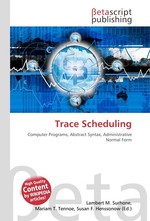Trace Scheduling
Lambert M. Surhone, Mariam T. Tennoe, Susan F. Henssonow
бумажная книга
Please note that the content of this book primarily consists of articles available from Wikipedia or other free sources online. Trace scheduling is an optimization technique used in compilers for computer programs. A compiler often can, by rearranging its generated machine instructions for faster execution, improve program performance. Trace scheduling is one of many known techniques for doing so. Trace scheduling was originally developed for Very Long Instruction Word, or VLIW machines, and is a form of global code motion. It works by converting a loop to long straight-line code sequence using loop unrolling and static branch prediction. This process separates out "unlikely" code and adds handlers for exits from trace. The goal is to have the most common case executed as a sequential set of instructions without branches.
Данное издание не является оригинальным. Книга печатается по технологии принт-он-деманд после получения заказа.


